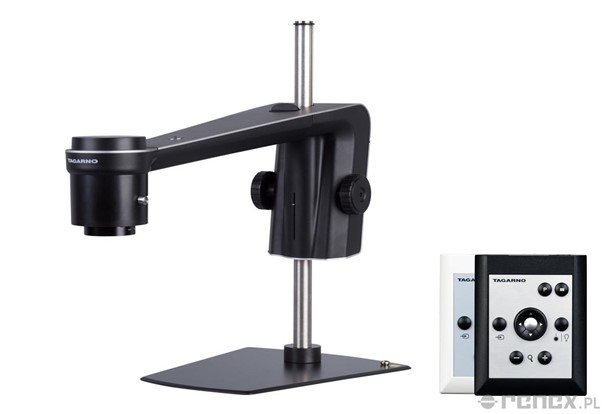mar 28, 2023
Optical inspection in the electronics industry – digital microscopes
Market pressures are forcing manufacturers to increasingly miniaturise their electronics. The new phones, computers and other multifunctional devices coming out every year have to be more and more powerful without increasing their size in order to be competitive. As a result, electronic packages use smaller and smaller components in ever-increasing densities. This has had a knock-on effect – forcing not only manufacturers, but also their subcontractors and electronics service providers to adapt to the realities of working with highly miniaturised electronics.
The problem of demanding inspection of electronics can be seen right from the visual inspection stage. Standard magnifying glasses on illuminated workstations are now becoming an auxiliary tool, allowing only a cursory inspection of the entire electronic system. The magnifications they offer (typically 1.7x to 3x) are clearly insufficient for working with the finest electronic components. Microscopes began to be used as a solution to this problem. There are two types of these devices that are currently the most popular: stereo microscopes and digital microscopes.
Stereoscopic microscopes are popular and widely used devices in various scientific and industrial fields. Thanks to their optics, they allow accurate and spatial observation of points. However, their body position forced on the operator, who has to bring his or her eyes closer to the eyepieces and remain in this position throughout the work, is a serious disadvantage. This is especially true in the case of in-line supplementary assembly, where operators have to work in a hunched over position for entire working days. This in turn can lead to musculoskeletal disorders, headaches and eye pain. Another disadvantage is that simultaneous work on the machine is limited to only one person. For this reason, digital microscopes, which solve these problems, are becoming increasingly popular. In the electronics industry, digital microscopes are becoming increasingly popular as they are more convenient to use than traditional stereo microscopes. Digital microscopes, also known as video microscopes, use a digital camera with a macro lens that transmits live images to a monitor.

This type of microscope allows people to work comfortably in an upright position, which minimises the risk of occupational skeletal disorders, headaches and eye pain. What’s more, digital microscopes allow several people to work simultaneously on a single device, which significantly increases work efficiency. Digital microscopes, unlike conventional stereoscopic microscopes, allow the operator to conveniently position the monitor and view the image in a position of their choice, allowing them to work in an upright position. In addition, the image can be analysed by several specialists simultaneously and, thanks to remote image transmission, also by specialists working remotely. This working flexibility brings new, dynamic ways of working, greater inspection confidence and innovative ideas.

Digital microscopes allow high magnifications, even higher than stereo microscopes, up to 600x. They typically operate at a high resolution of 1080p/60Hz. However, there are some limitations due to the principles of photography. Digital camera matrices have a smaller tonal range than the human eye, which can lead to underexposure or overexposure of very bright and dark areas at high magnifications. Nevertheless, digital microscopes are the most popular and very versatile inspection devices today.
Digital microscopes have become a popular solution in the electronics industry, with the most common applications being complementary assembly and repair. Particularly noteworthy are the various models of digital microscopes from the TAGARNO brand, which have gained much recognition in Poland. One of the most sought-after devices in electronic manufacturing is the TAGARNO MAGNUS TREND FHD, which offers realistic images of the highest quality, without noise or delay.
With the ability to display the image on the monitor, the operator can work comfortably in an upright position. The unit also has a large workspace, allowing the use of a variety of tools used in the electronics industry. It is ideal for repair and modification workstations.
Digital microscopes are used in a wide range of fields, including current inspection. Their main purpose is to enable quality and process control at various stages of production. Similar devices are also used in design departments during prototyping, where, in addition to inspection, they also enable the archiving of work progress and potential imperfections in the process. Among the optimum solutions is the TAGARNO MAGNUS ZAP FHD device, which has a built-in controller that eliminates unnecessary cables and is mounted on a stable arm for convenience of use and ease of positioning the camera lens over the PCB to be inspected.
In order to improve the operator’s workflow and provide better quality and process control, TAGARNO’s software offers tools that allow the comparison of the prototype produced with the design or model product.

For this purpose, the monitor can be divided into two parts, making it easier to compare and analyse data. In addition, digital microscopes enable non-contact and highly precise measurement of workpieces, which is particularly important in the electronics and mechanical industry. Thanks to the ability to save successive images while working with digital microscopes, it is possible to keep detailed records of the progress of work, errors detected and technological changes made. In this way, we gain the ability to easily follow the history of a project or production process, which translates into efficiency and quality of work.
Summary
With the advancement of miniaturisation in the manufacturing and servicing of electronic packages, digital microscopes have become an indispensable tool in the industry. Before purchasing, it is advisable to consult an experienced consulting partner and test the device in operation. The RENEX Group, one of the largest and most experienced companies in the electronics industry, offers advisory support to entrepreneurs interested in developing electronics production and service in Poland and Central and Eastern Europe. Equipment from the RENEX range can be tested in action on the production line at the Technology and Training Centre. TAGARNO digital microscopes are also available for on-site testing. For more information, you can contact RENEX technical and sales advisors at dth@renex.pl or visit www.renex.pl.
